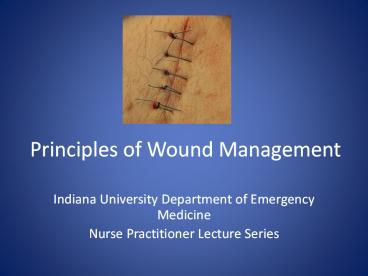Principles of Wound Management - PowerPoint PPT Presentation
1 / 13
Title:
Principles of Wound Management
Description:
... lubricant jelly are good alternatives Wound Irrigation Most important determinant in ... use of wound irrigation General rule is at least 50 cc of ... – PowerPoint PPT presentation
Number of Views:425
Avg rating:3.0/5.0
Title: Principles of Wound Management
1
Principles of Wound Management
- Indiana University Department of Emergency
Medicine - Nurse Practitioner Lecture Series
2
Skin Preparation
- Used to decrease bacterial counts surrounding
wounds - Povidine-Iodine solution (Betadine) and
Chlorhexidine (Hibiclens) solutions are
available - can be used to cleanse surrounding skin surfaces
but may inhibit the immune response when placed
within wounds.
3
Hair and Eyebrows
- Dont shave, this increases infection 10x
secondary to abrasions produced by razor - Potential that the eyebrow may not grow back
- Clipping of hair or applying lubricant jelly are
good alternatives
4
Wound Irrigation
- Most important determinant in decreasing risk of
infection - Goal is decreasing bacterial load within wounds
- High-pressure irrigation
- Technique seems to be more important than type of
irrigation solution used - Approx. 7 psi needed to significantly decrease
bacterial load and rate of infection - Accomplished with a 18g angiocath with large
syringe.
5
(No Transcript)
6
Wound Irrigation
- Low pressure irrigation is not as effective as
high pressure irrigation - Pouring
- Soaking
- Gravity wash
- Poke a hole in the top of a bottle
- Bulb syringe
- All do not create enough pressure
7
Wound Irrigation
- Normal saline shown to be as effective (and more
cost effective) than other commercial solutions - Do Not use betadine, hydrogen peroxide, or
isopropyl alcohol - Tissue toxicity
- The KEY is copious use of wound irrigation
- General rule is at least 50 cc of irrigation
applied with at least 7psi of pressure per cm of
wound
8
Wound Closure
- Three options
- Healing by primary intention
- Healing by secondary intention
- Delayed primary closure
- Choice is based on risk for infection, location
and inherent wound characteristics
9
Healing by Primary Intention
- Also called primary closure
- Most common method used
- Wound bandaged, glued, stapled or sutured
10
Healing by Secondary Intention
- Wound is left open and allowed to granulate from
within - Grossly contaminated and other high risk wounds
can be handled this way - Often results in less desirable functional and
cosmetic outcome
11
Delayed Primary Closure
- Useful for wounds which are high risk for
infection, but where the cosmetic outcome of
secondary intention would be undesirable - Wounds are left open, packed, and covered with a
dressing - 3-5 days later the wound is debrided and closed
12
Method of Closure
- Goal of primary closure is to approximate the
wound edges with the best cosmetic outcome - Scaring is the result of tension on wound edges
and wound contraction with healing - Gaping wounds tend to scar more because of
increased tension on the wound - Everting wound edges results in a better outcome
because it allows for wound contraction
13
(No Transcript)































